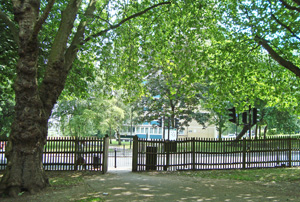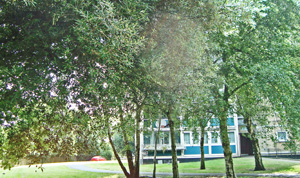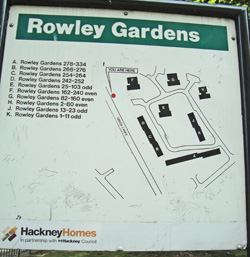Northumberland House
Green Lanes, Finsbury Park, N4 1HL
Medical
dates:
Medical
character:
Mental (Licensed House)
Northumberland House opened in
1829 as a private lunatic asylum for the care of ladies and
gentlemen of the upper and middle classes. It was licensed to
accommodate 40 patients, with Richard Birkett, a stationer, as licensee.
The large 3-storey mansion was set in extensive grounds. Built in 1822 to resemble a country house, it had a pillared entrance, balustrades and urns upon the roof.
A visit by the Metropolitan Commissioners in Lunacy in July 1829 found the house to be in good order, "with the exception of the Crib Room, which is very offensive" (Patients "with faulty habits", i.e. who wet or soiled themselves at night, slept on cribs - beds with bases of wooden slats with loose straw as a mattress. The straw was supposed to be changed every day.)
In 1830 the asylum contained 12 male and 9 female patients.
In 1835 the weekly charge for a patient varied from 1.5 to 5 guineas (£1.57 to £5.25).
In 1841 the asylum contained 47 patients.
In 1850 the lease was acquired for another 3.5 acres of land, after which the asylum had 7 acres of grounds. In the following year there were 63 inmates.
During the summers, groups of patients were taken on holiday to the seaside.
In 1859, on the death of Richard Birkett, the license passed to Dr George Birkett and Mr Richard Birkett.
In the 1860s a row of semi-detached villas was built close to the asylum's principal field and cricket ground. To maintain privacy of the patients, the nearest two were purchased by the asylum and included in the license. They were then refurbished for patients - 5 men in one house and 5 women in the other. Only the quieter and harmless types were accommodated in them.
In 1867 there were 50 patients - 30 men and 20 women.
In 1877 the asylum was bought by Dr Alonzo Henry Stocker, the owner of Peckham House in south London. One of the best known specialists in lunacy, he had become Medical Superintendent of Grove Hall Asylum, Bow, in 1852 at the age of 22 years.
In the summer, patients were able to go to Craigweil House, a large house in Bognor Regis bought by Dr Stocker for use by his patients from Peckham House.
In 1881 the asylum had 78 patients. The weekly charge was three guineas (£3.15), although some older long-stay patients paid two guineas (£2.10) or less. Trustworthy patients were allowed to leave the asylum grounds and visit Finsbury Park for walking exercise.
Several structural improvements had been initiated during the previous two years by the Resident Medical Superintendent, Dr F.J. Wright. The main building provided accommodation for the patients and the Assistant Medical Officer. Included in the license were the small semi-detached houses, now five in number, accessible from the grounds of the mansion. Two of these houses had been made into a single dwelling for Dr Wright and his family, while the other three accommodated patients of the quieter kind.
By 1882 it was one of nine Metropolitan Licensed Houses receiving private patients only (the others were Manor House, Brooke House, Sussex House, Brandenburgh House, Wyke House, Southall Park, Halliford House and Twickenham House).
In August 1899 the asylum contained 38 male and 52 female Certified patients and one Voluntary boarder. The staff consisted of a Matron and a housekeeper, and 16 male and 19 female attendants.
In January 1900, at the turn of the century, there were 34 male and 57 female patients.
In February 1901, when the Commissioners in Lunacy visited, there were 25 male and 48 female patients. The Commissioners found the rooms to be warm and comfortable. The male padded room, which had been badly damaged at Christmas, was not yet repaired.
The padded room was repaired in March 1901, but the work was not very well done. The rooms in the villas were also repaired and redecorated. The garden was divided, so that both sexes could use it at the same time.
In the same month there was an outbreak of enteritis, possibly from the milk supply. Seven patients were affected and one nurse died of it.
In 1901 the staff on the male side of the asylum consisted of a Head Attendant, 2 charge attendants and 8 ordinary attendants, plus 2 attendants at night. On the female side there were a Matron, 3 charge nurses and 9 ordinary nurses, plus 2 at night.
Carriage exercise was available at the asylum, but cost extra. Travelling in a carriage was thought to be beneficial to the internal organs, as the jolts and shocks from the carriage wheels going over rough ground were transmitted through the flooring to the passenger.
At the beginning of 1902 the asylum contained 28 male and 53 female patients. The male side had 10 attendants and the female 17, with 2 on each side at night. It had been decided that the villa at No. 350 Green Lanes would be occupied by female instead of male patients. The interconnecting doors therefore had to be securely locked with special keys.
In January 1903 there were 31 male and 51 female patients. A shelter against the sun and light rain was provided in the south wing garden. In the summer groups of patients were taken on holiday to Bognor Regis. The asylum was maintained in good order; patients were rarely mechanically restrained but unreasonable behaviour was punished by seclusion for a period of hours.
In January 1904 there were 29 male and 49 female patients. Dances and entertainments were organised. Religious services were held on Sunday afternoons.
In January 1905 the staff consisted of 11 male attendants and 16 nurses, plus a night attendant on each side of the asylum. There were 23 male and 52 female patients.
The license was renewed in 1906, when there were 24 male and 48 female patients. The building was redecorated and re-papered with cheerful wallpaper. More pictures were hung on the walls. There were 24 male and 48 female patients.
In 1907 fire escapes were fitted to the villas. The asylum contained 25 male and 53 female Certified patients, plus one male and two female Voluntary boarders. The staff ratio to patients was 1:2.5 males and 1:4.75 females.
In January 1908, when there were 28 male and 54 female patients, No. 252 Green Lanes was given over to female patients. The five male patients residing there were moved to the East Wing.
In 1909 and 1910 there were 32 male and 54 female patients.
Dr Alonzo Henry Stocker died at the age of 81 in 1910, but his family continued to run the asylum. His son, Dr Alonzo Harold Stocker, took over as proprietor.
In January 1911 there were 32 male and 56 female patients, suffering from psychosis and other mental and nervous illnesses.
In 1912 the post of Medical Superintendent was advertised at a salary of £300 a year (increasing to £400). (An Assistant Medical Officer received a salary of £135 per annum, increasing to £150.) In that year the asylum contained 34 male and 52 female patients.
In 1916 the weekly charge for a patient was 3 guineas (£3.15) upwards.
During WW2 (1939-1945) an A.R.P. shelter was built in the grounds.
In 1948 the asylum did not join the NHS but remained a private institution.
In 1951 there were 59 patients.
In 1954 the property was acquired by the LCC for a housing estate, and the asylum moved to Ballards Lane, Finchley, where it became the Northumberland House Nursing Home.
Present status (June 2009)
The large 3-storey mansion was set in extensive grounds. Built in 1822 to resemble a country house, it had a pillared entrance, balustrades and urns upon the roof.
A visit by the Metropolitan Commissioners in Lunacy in July 1829 found the house to be in good order, "with the exception of the Crib Room, which is very offensive" (Patients "with faulty habits", i.e. who wet or soiled themselves at night, slept on cribs - beds with bases of wooden slats with loose straw as a mattress. The straw was supposed to be changed every day.)
In 1830 the asylum contained 12 male and 9 female patients.
In 1835 the weekly charge for a patient varied from 1.5 to 5 guineas (£1.57 to £5.25).
In 1841 the asylum contained 47 patients.
In 1850 the lease was acquired for another 3.5 acres of land, after which the asylum had 7 acres of grounds. In the following year there were 63 inmates.
During the summers, groups of patients were taken on holiday to the seaside.
In 1859, on the death of Richard Birkett, the license passed to Dr George Birkett and Mr Richard Birkett.
In the 1860s a row of semi-detached villas was built close to the asylum's principal field and cricket ground. To maintain privacy of the patients, the nearest two were purchased by the asylum and included in the license. They were then refurbished for patients - 5 men in one house and 5 women in the other. Only the quieter and harmless types were accommodated in them.
In 1867 there were 50 patients - 30 men and 20 women.
In 1877 the asylum was bought by Dr Alonzo Henry Stocker, the owner of Peckham House in south London. One of the best known specialists in lunacy, he had become Medical Superintendent of Grove Hall Asylum, Bow, in 1852 at the age of 22 years.
In the summer, patients were able to go to Craigweil House, a large house in Bognor Regis bought by Dr Stocker for use by his patients from Peckham House.
In 1881 the asylum had 78 patients. The weekly charge was three guineas (£3.15), although some older long-stay patients paid two guineas (£2.10) or less. Trustworthy patients were allowed to leave the asylum grounds and visit Finsbury Park for walking exercise.
Several structural improvements had been initiated during the previous two years by the Resident Medical Superintendent, Dr F.J. Wright. The main building provided accommodation for the patients and the Assistant Medical Officer. Included in the license were the small semi-detached houses, now five in number, accessible from the grounds of the mansion. Two of these houses had been made into a single dwelling for Dr Wright and his family, while the other three accommodated patients of the quieter kind.
By 1882 it was one of nine Metropolitan Licensed Houses receiving private patients only (the others were Manor House, Brooke House, Sussex House, Brandenburgh House, Wyke House, Southall Park, Halliford House and Twickenham House).
In August 1899 the asylum contained 38 male and 52 female Certified patients and one Voluntary boarder. The staff consisted of a Matron and a housekeeper, and 16 male and 19 female attendants.
In January 1900, at the turn of the century, there were 34 male and 57 female patients.
In February 1901, when the Commissioners in Lunacy visited, there were 25 male and 48 female patients. The Commissioners found the rooms to be warm and comfortable. The male padded room, which had been badly damaged at Christmas, was not yet repaired.
The padded room was repaired in March 1901, but the work was not very well done. The rooms in the villas were also repaired and redecorated. The garden was divided, so that both sexes could use it at the same time.
In the same month there was an outbreak of enteritis, possibly from the milk supply. Seven patients were affected and one nurse died of it.
In 1901 the staff on the male side of the asylum consisted of a Head Attendant, 2 charge attendants and 8 ordinary attendants, plus 2 attendants at night. On the female side there were a Matron, 3 charge nurses and 9 ordinary nurses, plus 2 at night.
Carriage exercise was available at the asylum, but cost extra. Travelling in a carriage was thought to be beneficial to the internal organs, as the jolts and shocks from the carriage wheels going over rough ground were transmitted through the flooring to the passenger.
At the beginning of 1902 the asylum contained 28 male and 53 female patients. The male side had 10 attendants and the female 17, with 2 on each side at night. It had been decided that the villa at No. 350 Green Lanes would be occupied by female instead of male patients. The interconnecting doors therefore had to be securely locked with special keys.
In January 1903 there were 31 male and 51 female patients. A shelter against the sun and light rain was provided in the south wing garden. In the summer groups of patients were taken on holiday to Bognor Regis. The asylum was maintained in good order; patients were rarely mechanically restrained but unreasonable behaviour was punished by seclusion for a period of hours.
In January 1904 there were 29 male and 49 female patients. Dances and entertainments were organised. Religious services were held on Sunday afternoons.
In January 1905 the staff consisted of 11 male attendants and 16 nurses, plus a night attendant on each side of the asylum. There were 23 male and 52 female patients.
The license was renewed in 1906, when there were 24 male and 48 female patients. The building was redecorated and re-papered with cheerful wallpaper. More pictures were hung on the walls. There were 24 male and 48 female patients.
In 1907 fire escapes were fitted to the villas. The asylum contained 25 male and 53 female Certified patients, plus one male and two female Voluntary boarders. The staff ratio to patients was 1:2.5 males and 1:4.75 females.
In January 1908, when there were 28 male and 54 female patients, No. 252 Green Lanes was given over to female patients. The five male patients residing there were moved to the East Wing.
In 1909 and 1910 there were 32 male and 54 female patients.
Dr Alonzo Henry Stocker died at the age of 81 in 1910, but his family continued to run the asylum. His son, Dr Alonzo Harold Stocker, took over as proprietor.
In January 1911 there were 32 male and 56 female patients, suffering from psychosis and other mental and nervous illnesses.
In 1912 the post of Medical Superintendent was advertised at a salary of £300 a year (increasing to £400). (An Assistant Medical Officer received a salary of £135 per annum, increasing to £150.) In that year the asylum contained 34 male and 52 female patients.
In 1916 the weekly charge for a patient was 3 guineas (£3.15) upwards.
During WW2 (1939-1945) an A.R.P. shelter was built in the grounds.
In 1948 the asylum did not join the NHS but remained a private institution.
In 1951 there were 59 patients.
In 1954 the property was acquired by the LCC for a housing estate, and the asylum moved to Ballards Lane, Finchley, where it became the Northumberland House Nursing Home.
Present status (June 2009)
The building was demolished in 1955. Rowley Gardens, a series of 10-storey blocks on the Woodberry Down Estate, was built on the site of the asylum and its grounds.

The site of the asylum viewed from the southeast.

The site from the park (above) and from the riverside (below).


Rowley Gardens now occupies the site of the house and the grounds.
(Author unstated) 1882 Thirty-sixth Report of the Commissioners in Lunacy to the Lord Chancellor. Parliamentary Papers, 32. London, The House of Commons.
(Author unstated) 1910 Obituary. Dr Alonzo Henry Stocker. British Medical Journal 1 (2575), 1150.
http://en.wikipedia.org (1)
http://en.wikipedia.org (2)
http://studymore.org.uk
www.harringayonline.com (1)
www.harringayonline.com (2)
www.harringayonline.com (3)
www.thegazette.co.uk
www.wikiwand.com
Return to alphabetical list
Return to home page